|
The Burghley Street
warehouse
ALSO KNOWN AS SHILCOCK'S MILL
AND WHERRY'S MILL
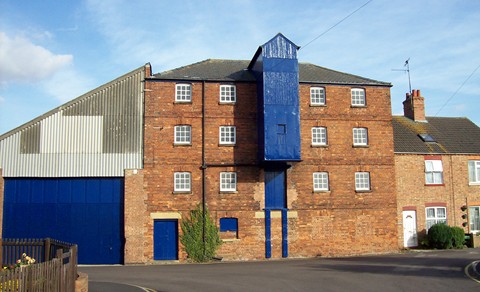
One of the last
remaining warehouses from the corn trade in Bourne still stands at the end
of Wherry's Lane overlooking the car park in Burghley Street and has had a
chequered history over two centuries.
The four-storey grain warehouse was built in the early years of the 19th
century but despite its age and architectural interest has not been listed
as worthy of preservation although this may change with the current
re-assessment of the Conservation Area for Bourne that is now underway.
It
was at one time owned by Robert James Shilcock (1823-1908), owner of the Star
Brewery but also had other business interests in the town including the
corn trade and the mill in South Street, now known as Baldock's Mill,
which he leased from 1856 although he employed a manager to run it. During this period the
Burghley Street warehouse was used as a maltings or
brewery and became known as Shilcock's Mill.
The warehouse was used for flax processing in the early years of the 20th
century and ownership subsequently passed to Wherry & Sons who used it to
store cotton cake, mollasine meal and other products for retailing to
local farmers and for the manufacture of compound animal feed, the
products being hoisted to the top floor for mixing before being passed
below to the first floor for bagging.
Animal feed production was eventually moved to the South Street warehouse
in 1954 and in 1956 the company added an asbestos extension to the building to house a
new cereal seed cleaning plant while the original brick section was used for
the mixing of clover and grass seed. During this period it was sometimes
known as Wherry's Mill.
Wherry's sold the building to Nursery
Supplies (Bourne) Ltd which used it for storage and distribution but the
firm closed down in 2001 when ownership passed to Warners (Midlands) plc,
the local printing firm, but had only sporadic use although occasionally maintained,
including re-painting during 2002.
In 2008, the warehouse was bought by South Kesteven
District Council for £350,000 as part of the
proposed redevelopment of the town centre. In September 2009, the council posted a notice on the north wall
announcing its intention to include the building in the
forthcoming scheme but no details of how it would be used were given.
Various community roles were suggested, such as a block of flats, library
and even an arts centre, but none came to fruition because the entire town centre scheme was abandoned in 2010.
The
following year the council proposed a more modest scheme for the
refurbishment of Wherry's Lane only at a cost of £2.2 million. This would
involve turning the warehouse into a complex of fourteen first and
second floor apartments with an arcade of seven shops behind and work
began on the project in the autumn of 2012.
Work was nearing completion in the summer of 2013 when South Kesteven
District Council was taken to task by a local resident for failing to
observe its own planning guidelines when restoring the warehouse. He
pointed out that the frontage has an established pattern of window design
from the period in which it was built but those in the grain hoist section
had been replaced with new ones that were totally inappropriate.
“I would have expected them to be made with glazing bars and wide frames
to match the original windows but instead they have been done as cheaply
and tattily as possible”, wrote Robert Harvey of Beech Avenue, Bourne, in
his letter of protest to the council on 29th July. “I do not doubt that windows are
required in a position where formerly there were none and I imagine that
they are needed to light some new internal corridor but this should have
been done with far more care to match what is already there. Were this the
property of a private individual and those windows had been fitted I would
have expected your office to have been complaining immediately until they
were changed.”
Mr Harvey has also condemned the wooden cladding that had been added and
said that the shape of the barge boards and the lower course of tiles had
nothing to do with a building of this age. “I have no doubt we will grow
accustomed to these”, he said, “but there is no hope of ever forgiving the
hideous windows.”
Although not listed, the warehouse does stand within the town’s
Conservation Area and Mr Harvey claimed that the work breached the
council’s own guidelines for property owners in conservation areas which
quite clearly stated that where there was an established pattern of window
design or glazing and it was considered important for the character or
appearance of the building, the new windows should be designed to take
account of the existing design and glazing. “But these do no such thing”,
he said. “They are hideously out of place.”
He went on: “No doubt planning permission was given but it should not have
been and the council should think very seriously about why it was. This
redevelopment was an opportunity for the council to take the lead and show
other property owners the standard to which they should aspire but in
this case they have set a bad
precedent.”
The council, however, did not agree, claiming that the overall conversion
had significantly enhanced the building and the surrounding area as well
as preserving a major, undesignated heritage asset. “It is considered that
the scheme has resulted in an overall enhancement of its appearance by
removing large unsightly additions and restoring the historic fabric”,
said Justin Johnson, the principal planning officer, in his reply on
September 16th. “The windows used in the main building are of timber
construction and of similar design to the original windows. With regard to
the windows in the sack hoist, it is considered that the use of similar
windows to that in the main building with glazing bars would have been
architecturally inappropriate. The original sack hoist was patched up and
unsightly. The sack hoist has been completely replaced with a new
structure and it is considered that the windows are appropriate for this
element of the building and the timber boarding will weather naturally
over time.”
Planning permission was no doubt passed on the nod by the council but if
the building had been Grade II listed it is quite certain that this work
would not have been carried out without detailed investigation when it
would have been subjected to the utmost scrutiny with input from the
public and our various conservation organisations, including English
Heritage, with final approval needed from the Department of Culture, Media
and Sport. Certainly one aspect of the development that would have
occupied their attention yet seems to have escaped the district council is
the misalignment of the window on the left in the new bottom row that has
disrupted the entire symmetry of the facade, a glaringly obvious detail
that certainly would not have received the approval of English Heritage.
As it is, we have a fait accompli and it will therefore be up to the
people of Bourne to judge whether work on the grain warehouse is a
hotchpotch or a sympathetic conversion although, more importantly, history
will make the final appraisal as to whether it becomes an important part
of our heritage or a missed opportunity.
|
PHOTO ALBUM |
|
 |
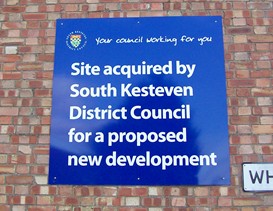 |
|
The Burghley Street warehouse when used by
Nursery Supplies and the redevelopment sign erected by South
Kesteven District Council in 2009. |
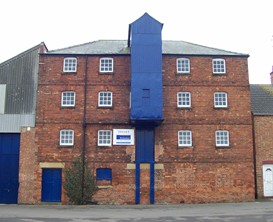 |
 |
|
The warehouse was put on the market in January
2010 seeking offers to rent and suitable for storage or community
use but only for the ground floor, the first, second and third
floors of the front section being excluded from any lease for safety
reasons. The property was described as being a substantial brick
built warehouse of basic construction beneath an asbestos cement
covered roof with a concrete floor and a timber, sliding vehicle
loading door to Burghley Street. |
|
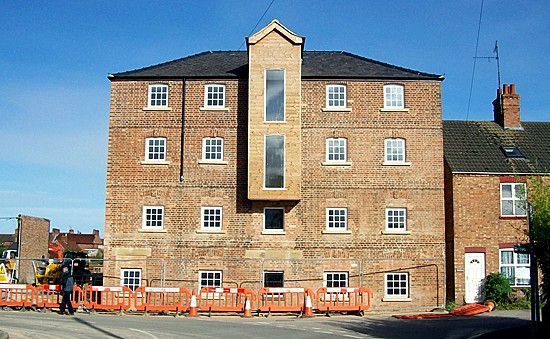 |
|
Work was nearing completion in September 2013
when a complaints was lodged with South Kesteven District Council
that the central windows over the former grain hoist were
incongruous and out of keeping with the history of the building and
the council's own guidelines for buildings within the Conservation
Area. However, the council has introduced rather nice touch with the
addition of bat boxes on either side of the grain sack hoist near the
roof for any bats that may have been disturbed during construction
work.. |
 |
 |
|
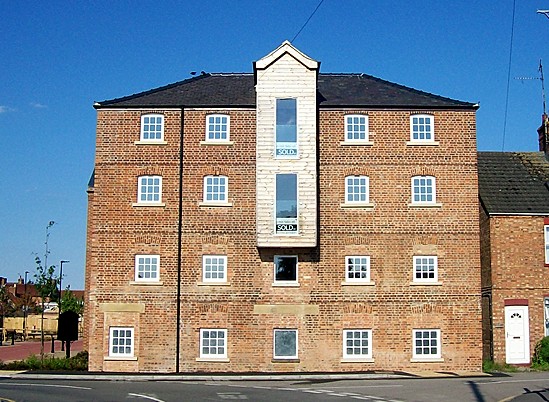 |
|
The finished restoration with fourteen flats up
for sale. |
|
SHILCOCK'S MILL IN PAST TIMES
The mill was used for a time by Wherry & Sons
as a seed processing plant under foreman, Charlie Porter, who is
seen here mixing grass seed by hand. The apparatus on the right is
known as a dosser and was used to separate dock from clover seed.
The business was run by James Wherry from his tiny room at the
company's offices in North Street, now demolished. |
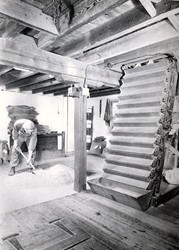 |
NOTE: Acknowledgments to Seven Generations of a Family Business - The
Story of
Wherry & Sons Ltd., published 2009.
REVISED SEPTEMBER 2013
See also
The Wherry's Lane redevelopment
Robert Shilcock
Flax
Wherry & Sons
The corn trade

Go to:
Main Index Villages
Index
|






